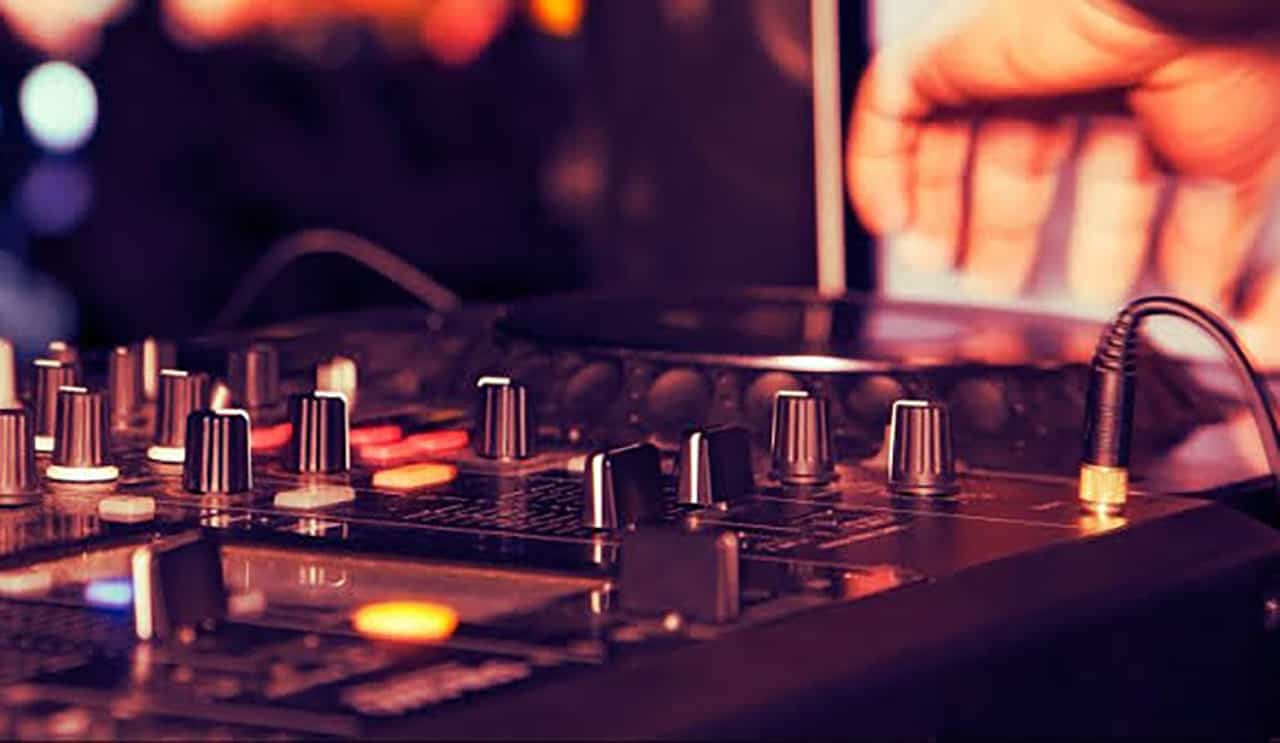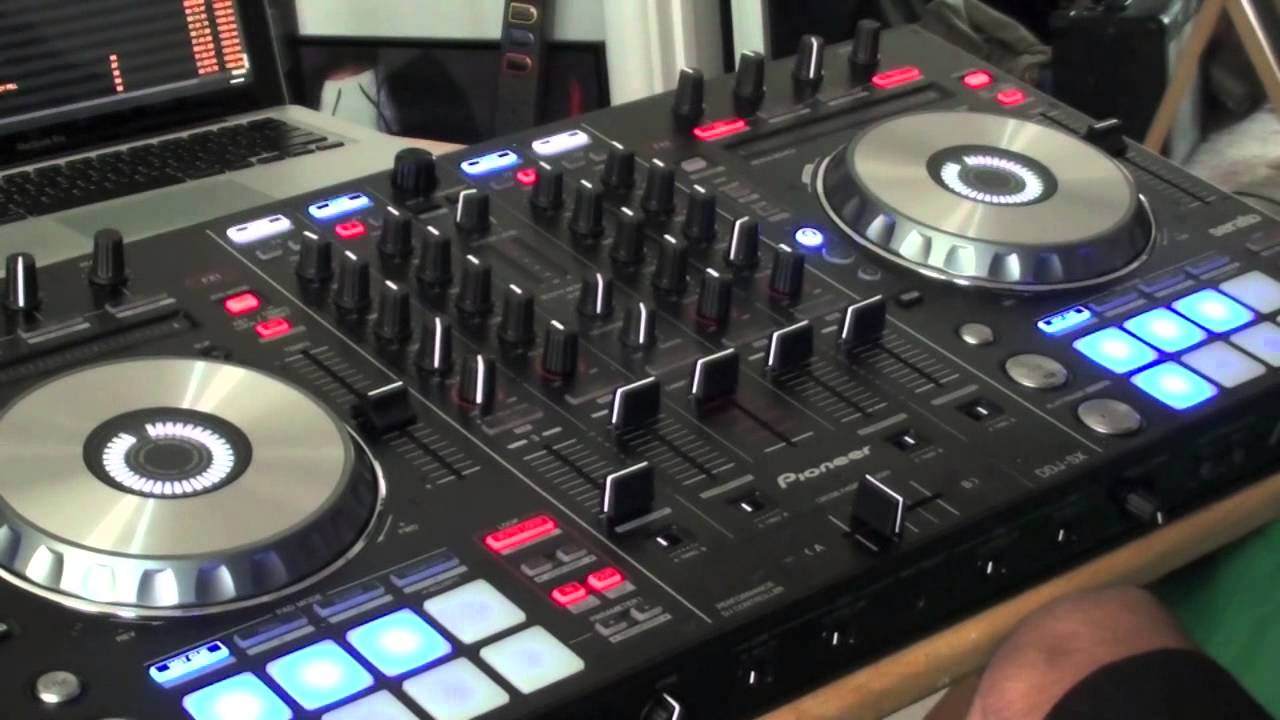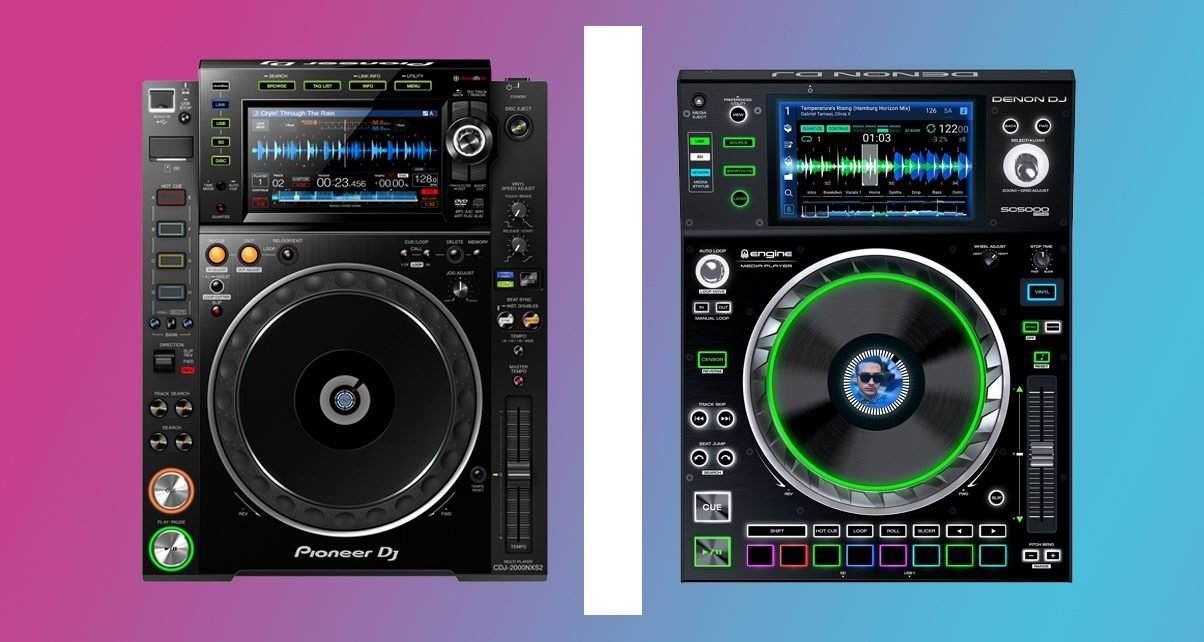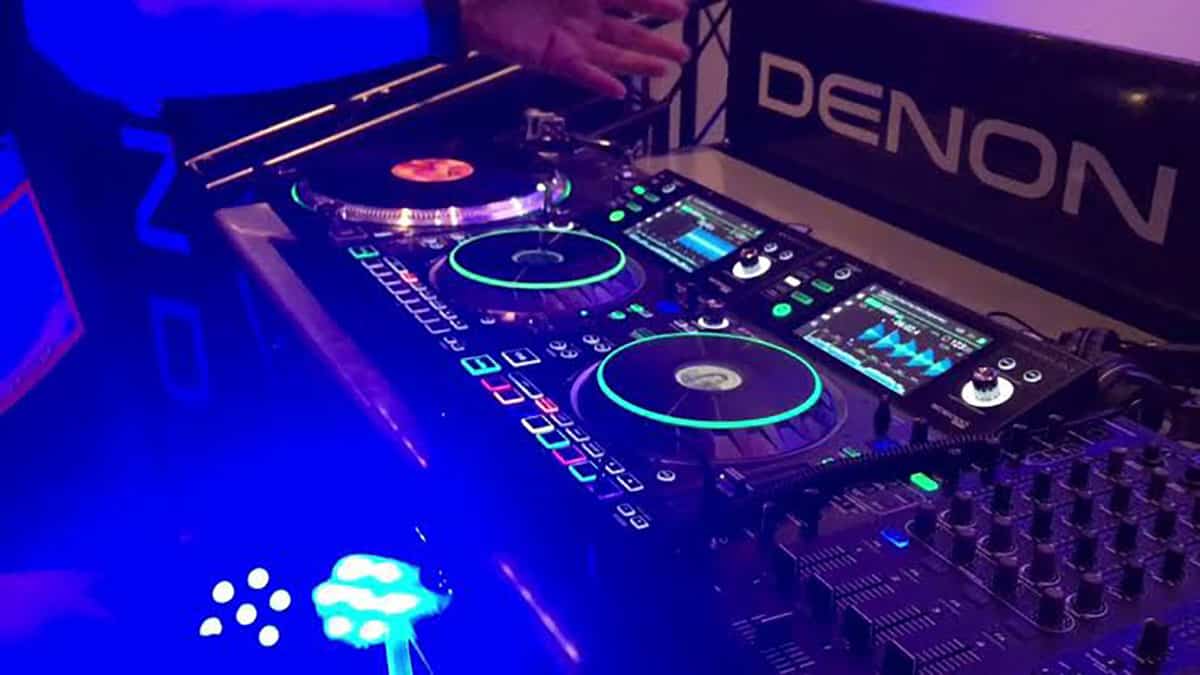Disclosure: This post contains affiliate links, which means we may earn a commission if you purchase through our links at no extra cost to you.
Table of Contents
Introduction to DJ Mixing
Simply defined, DJ is taking the already existing music and playing it in a way it pleases the crowd.
As simple as it may sound, it is very tough to do so since it demands not only a lot of expertise but also dealing with various tasks at a time.
What makes DJ stand out from playing the plain songs through speakers is the wide range of options it provides to experiment with the existing music.
That’s exactly where the DJ mixing and the DJ mixer find their prominence. Without these, effective DJ functioning is impossible.
he mixer is a key part of the entire DJ setup which ensures that the transitions between the songs are done smoothly. Let’s explore more about DJ mixer, it’s components and functioning.
Components and functioning of a DJ mixer
The DJ mixer will usually have two channels and the input can be processed to either of them. The inputs can be CD decks, laptops, vinyl turntable, etc..,
However, processing the inputs through vinyl turntable is a more popular way these days.
Other key components of the DJ mixer include the “UP Fader” that controls the volume of the channel and the “Cross Fader” that moves between the channel (plays left channel when turned left plays right channel when moved right and plays both the channels at the same time if placed in the middle).
Gameknobs on each channel acts as an amplifier, controls volume to match with the tracks.
Equalizers will allow us to control the frequencies. The “Q” section allows the DJ to hear a song in the headphones while the other one is being played for the crowd.
“Pitchfader” is another essential component in the deck part which allows us to speed up and slow down the individual tracks.
“Platters” are used for backward and forward motion while playing the song. Pause, play and cue are the other key components of the DJ mixer.
Now that the basic functioning is clear, let’s see the top-rated DJ mixers globally (Data gathered from various sources), their pros and cons
1. Pioneer DJMNXS2
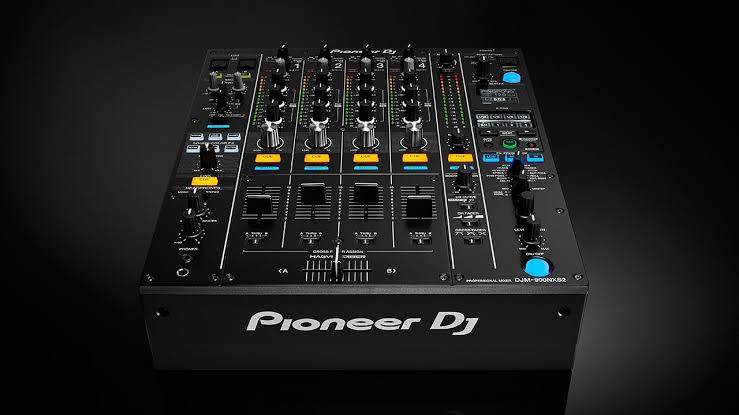
This mixer particularly is more famous in the club scenario. The nexus which is 4 channel DJ mixer is particularly compatible with record box but not with Serato and Traktor.
It contains a lot of good features that were there in the earlier pioneer DJM 900 nexus and additionally has certain improved features too.
Some of them include dual USB ports, improved sound quality, improved crossfader functioning, etc..,
The back rear panel contains on/off toggle switch, AC power input, steady ground post, four input channels on the top, outputs in the bottom. The outputs contain master 1, master 2 output, record output, and booth output.
Link helps in linking things with another player. Mic1 and mic 2 slots are there too.
The top part contains the Magvel crossfader at the bottom along with the crossfader assigns on its top. Above that are the line faders.
Above that are BFX indicators, cue indicators, sound color effect knobs, sound color fx part.
On the top are input lines, USB ports, eq knobs.
There are also microphone levels that be controlled to low, mid and high. The headphones section contains mixing and the volume control knobs.
The master control knob, the master metering are also present at the top right.
The right side also contains the DJ effects section which has x pad section, FX frequency that can be controlled as Low, medium and high, time knob to control the timings, level depth knobs to change the level and depth of the effects.
Pros
- Two USB sound card interfaces
- Sound color effects
- New Xpad, beat sections control the effects.
- Improved sound quality and a crossfader.
Cons
- Expensive
- Not compatible with Serato or Traktor DVS unlike the original nexus. Only compatible with record box DVS.
2. RANE 72 mixer
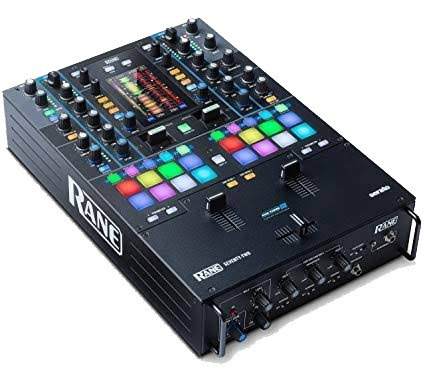
Rane 72 Serato DJ mixer has a two-channel scratch mixer and has Serato DJ mixer
It also has vinyl which can be used for the turntables
The build quality is heavy and good, most knobs are plastic, has a good touch screen with high resolution.
It also contains the Akai Mpc style pads.
The input and output section contains the power connector, on/off switch, USB a and USB b which can connect to two different USBs, two USB port hubs, phono grounds, main outputs contains two volume controls, auxiliary RCA, phono cd pair which can be used for both the decks, line and mic switch
The front panel contains, microphone 2 controls, echo control, volume level, on/off switch, footswitch connector, headphone output, deck swap switch, reverse on/off for all the faders.
The top view contains fader at the bottom, which can be adjusted manually, echo controls. The line and crossfaders are equally adjustable, cue buttons, the split cue can be used to play what’s playing in the headphones
The pad section is used to do various things such as pad effects, pitch play, flips, etc.., the Drumming capability of the pad section is great.
The shift button can be used to switch to other functions depending on the button we press.
Pros:
- mag 3 fader that is easily adjustable
- Dual USBs which are easy for change over
- Extensive pad functions such as cue, autoloop, pad effect, the fader and slicer effects
- High-resolution touch screen which helps in using the mixer effectively
- Internal Serato and DJ effects
Cons
- Expensive
- The screen and other effects are complicated since it takes a lot of time to understand before using them
3. Pioneer DJM S9
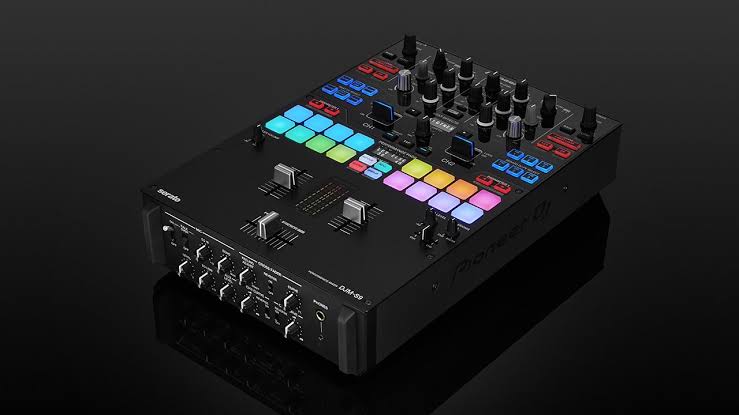
Pioneer DJM S9 is a professional two-channel DJ mixer.
It combines certain great features of the pioneer djmt1 mixer and the pioneer DJM 909 mixer. It comes along with the full Serato DJ software.
Hence it can be said that this mixer is stuffed with both Serato DJ and the pioneer DJ features.
It has a plastic covering to the bottoms and the sides, however, the front, rear, and top plate contain the metal.
It also comes bundled with the DVS vinyl so that we can use it with the turntables and also it can be used with CDs so that everything in the CD player can go through and route through the sound card to play the track files.
The front section contains microphone controls, on/off switch, talk over switch, adjust knob and echo knob.
It also has an eq and level knob, a crossfader section which allows to control and adjust the crossfader from heavy to slight.
It further contains channel curve and reverses switches which helps in changing some parameters.
The rear panel contains on/off power switch, ice styled power cable input, cd1/cd2 lines, cd line RCA, master RCA, dual amb style ports which helps in connecting to two different computers at the same time, auxiliary input and microphone input.
The top part contains input matrix-style switches that allow us to select in between the USBs, filter knobs which are used for high and low filters, shift button in the middle helps in changing things around, the right band left side has browse sections to change and chose the tracks.
The beat effects section has controls like echo, backspin, flanger, reverb, vinyl brake and phasers. There are Serato DJ effects on the right-hand side. Multiple effects can be enabled at a time.
The performance pads have RGB performance pads which whenever pressed creates certain effects in the middle while the music is being played.
We can use them for hot cues, flips, saved loop and there is also a user mode, the slicer loop and the sampler section, sampler volume knob, level and mixing knobs located to the bottom portion.
Finally, we can find the crossfader which is the pioneer’s Magvel version 2.
Pros:
- Pioneers solid DJ built quality, great excellent sound quality, Magvel pro crossfader which is easily adjustable, full Serato DJ experience, dual USB ports which is helpful in the crossover
Cons
- Expensive
- It doesn’t have a chance to combine different effects with each other (such as a Serato DJ effect mixed in with pioneer DJ effect at the same time).
- It doesn’t have a magnetic channel faders though they function well without them too. Minor negative. Faders adjustable and can be done a lot with them.
4. Behringer DDM4000
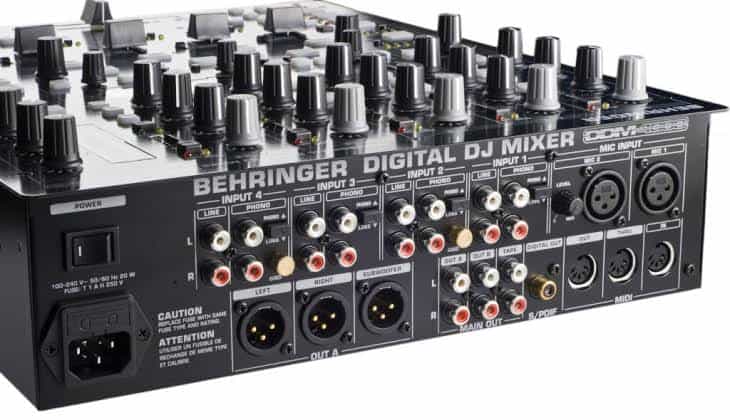
This is a Behringer’s flagship digital mini mappable mixer.
It contains four channels that can be assigned to phono and two mic inputs that can be controlled using hi, mid and low, volume control for the headphones.
Apart from these, there is a split button, cue buttons for various headphones to assist with the mixing.
There are in total 9 effects such as echo, flanger, phaser, filter, delay, pitch, etc.., There are two units to control these effects and also to indicate where these effects are wanted.
The sampler section is used to mention from where you want the sample from, also records the small sections of the audio if selected.
Apart from these, there are line faders and crossfader controls. Associated with them are hi, mid and lo control buttons.
Pros
- Decent built quality
- Effects quality are good
- Decent price
Cons
- Screen resolution could’ve been bigger
- Individual channel knobs could’ve been bigger so that the control could’ve been more efficient.
5. Allen and Heath Xone 23c
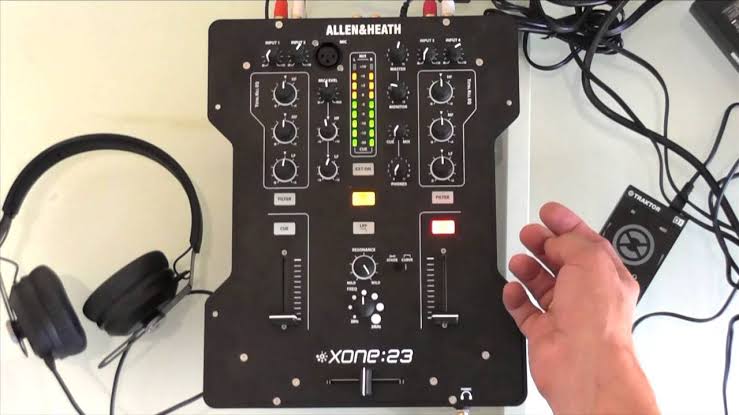
The Xone 23c has an internal USB DJ DVS capable soundcard-which comes with DJ software of your choice. It gives us a chance to control four inputs at a time. Small in size.
The inputs and outputs contain USB connection, Xlink, left and right phono end line, master Xlr output and also a monitor and recorder output.
On the top, it contains the crossfader might not work great for scratching but it works just fine in case of mixing, the line faders are a lot more resistant, filter effects in the middle, resonance and frequency knobs, cue buttons, cue mix, headphone volume control, eq knobs.
At the top, you have input buttons and there is also a microphone input button.
To set this up with the DVS, you have to open the mixer, attach the two jumpers using the details mentioned in the manual.
Pros
- Good mixer for those who want modular and small set up with best sound quality
- Good build quality
- Contains DVS sound card
Cons
- Crossfader need to be a little more efficient
- The mixer needs to be opened to change the DVS function

